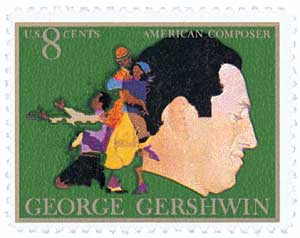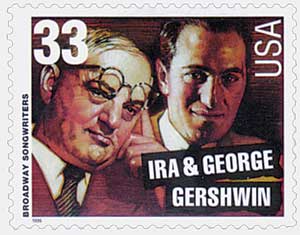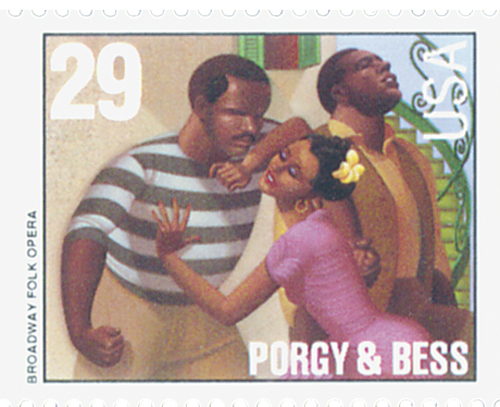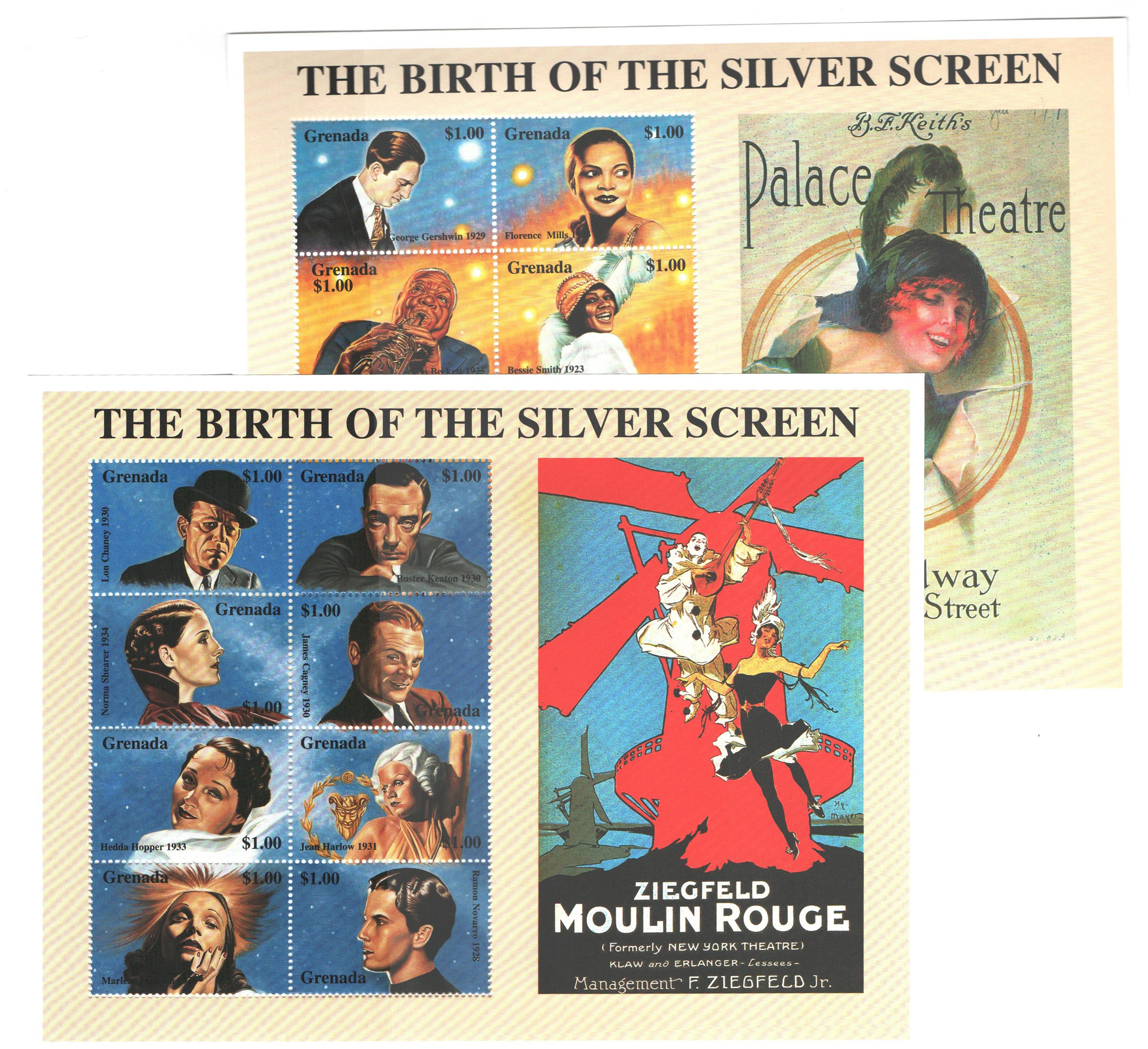
# 3345 - 1999 33c Broadway Songwriters: Ira and George Gershwin
33¢ Ira and George Gershwin
City: New York, NY
Quantity: 6,375,000
Printed By: Sterling Sommer for Ashton-Potter (USA) Ltd
Printing Method: Lithographed
Perforations: 11
Color: Multicolored
Birth of George Gershwin

George Gershwin was born Jacob Gershwine on September 26, 1898, in Brooklyn, New York. A successful composer and pianist, he created beloved orchestral compositions, popular jazz standards, as well as Broadway and Hollywood hits.

Born to Russian immigrants, George was the second of four children. His older brother Ira would also grow up to be a songwriter. The family moved frequently as their father explored a variety of business ventures. They spent most of their childhood in the Yiddish Theater District. George and Ira often went to local Yiddish theaters and George occasionally performed on stage as an extra.
Gershwin showed little interest in music until he was 10 years old. It was at that time he heard a friend play violin and was moved by the sound. Shortly after, his parents bought Ira a piano, but George ended up falling in love with it and playing it more. George then sought out a piano teacher, studying under Charles Hambitzer until 1918.

Gershwin dropped out of school at 15 to work as a song plugger in New York’s Tin Pan Alley. He was paid $15 a week to perform songs to help sell sheet music. Gershwin then published his first song, “When You Want ”˜Em, You Can’t Get ”˜Em, When You’ve Got ”˜Em, You Don’t Want ”˜Em,” in 1916, earning 50¢. That same year he began producing hundreds of songs for different music roll companies and self-playing pianos.
Gershwin briefly worked in vaudeville and found some success with his 1917 ragtime song, “Rialto Ripples.” He got his first national hit in 1919 with “Swanee,” which was made popular by performer Al Jolson. The first production for which he wrote the entire score was La, La Lucille (1919). Gershwin then collaborated with William Daly on the Broadway musicals Piccadilly to Broadway (1920), For Goodness’ Sake (1922), and Our Nell (1923).

Gershwin then composed his first major composition, Rhapsody in Blue, in 1924. It became his most popular work, emphasizing his talent for blending different musical styles, such as jazz and classical. In 1922, he worked on the experimental jazz opera, Blue Monday.
In the 1920s, Gershwin went to Paris for a while to study under French composers, but was turned down. Maurice Ravel told him, “Why become a second-rate Ravel when you’re already a first-rate Gershwin.” While in France, Gershwin wrote An American in Paris, which went on to become an American and European standard.

Over the course of his career, George and his brother Ira collaborated on more than 20 productions, including Lady Be Good (1924), Oh, Kay! (1926), Funny Face (1927), Strike Up the Band (1927), Show Girl (1929), and Girl Crazy (1930). These included popular songs “Embraceable You” and I Got Rhythm.” Their 1931 musical Of Thee I Sing became the first musical comedy to win the Pulitzer Prize for Drama.

In the summer of 1934, Gershwin visited DuBose Heyward, author of the novel Porgy. Gershwin was inspired by this meeting to compose the music for the opera Porgy and Bess (1935). It was initially a commercial failure, as critics couldn’t decide if it was an opera or Broadway musical. It eventually became the most popular opera written by an American composer.

In 1935, Gershwin moved to Hollywood, California, and turned his attention to films. He wrote Shall We Dance for Fred Astaire and Ginger Rogers, and A Damsel in Distress for Astaire, Joan Fontaine, and Gracie Allen. In 1937, Gershwin began suffering from painful headaches, coordination issues, and blackouts. He collapsed on the night of July 9 and was rushed to the hospital where doctors discovered he had a brain tumor. They rushed a neurosurgeon across the country to remove it, but Gershwin died on July 11, 1937 at just 38 years old. His death at such a young age was a shock to the world. A memorial concert was held at the Hollywood Bowl that September.
33¢ Ira and George Gershwin
City: New York, NY
Quantity: 6,375,000
Printed By: Sterling Sommer for Ashton-Potter (USA) Ltd
Printing Method: Lithographed
Perforations: 11
Color: Multicolored
Birth of George Gershwin

George Gershwin was born Jacob Gershwine on September 26, 1898, in Brooklyn, New York. A successful composer and pianist, he created beloved orchestral compositions, popular jazz standards, as well as Broadway and Hollywood hits.

Born to Russian immigrants, George was the second of four children. His older brother Ira would also grow up to be a songwriter. The family moved frequently as their father explored a variety of business ventures. They spent most of their childhood in the Yiddish Theater District. George and Ira often went to local Yiddish theaters and George occasionally performed on stage as an extra.
Gershwin showed little interest in music until he was 10 years old. It was at that time he heard a friend play violin and was moved by the sound. Shortly after, his parents bought Ira a piano, but George ended up falling in love with it and playing it more. George then sought out a piano teacher, studying under Charles Hambitzer until 1918.

Gershwin dropped out of school at 15 to work as a song plugger in New York’s Tin Pan Alley. He was paid $15 a week to perform songs to help sell sheet music. Gershwin then published his first song, “When You Want ”˜Em, You Can’t Get ”˜Em, When You’ve Got ”˜Em, You Don’t Want ”˜Em,” in 1916, earning 50¢. That same year he began producing hundreds of songs for different music roll companies and self-playing pianos.
Gershwin briefly worked in vaudeville and found some success with his 1917 ragtime song, “Rialto Ripples.” He got his first national hit in 1919 with “Swanee,” which was made popular by performer Al Jolson. The first production for which he wrote the entire score was La, La Lucille (1919). Gershwin then collaborated with William Daly on the Broadway musicals Piccadilly to Broadway (1920), For Goodness’ Sake (1922), and Our Nell (1923).

Gershwin then composed his first major composition, Rhapsody in Blue, in 1924. It became his most popular work, emphasizing his talent for blending different musical styles, such as jazz and classical. In 1922, he worked on the experimental jazz opera, Blue Monday.
In the 1920s, Gershwin went to Paris for a while to study under French composers, but was turned down. Maurice Ravel told him, “Why become a second-rate Ravel when you’re already a first-rate Gershwin.” While in France, Gershwin wrote An American in Paris, which went on to become an American and European standard.

Over the course of his career, George and his brother Ira collaborated on more than 20 productions, including Lady Be Good (1924), Oh, Kay! (1926), Funny Face (1927), Strike Up the Band (1927), Show Girl (1929), and Girl Crazy (1930). These included popular songs “Embraceable You” and I Got Rhythm.” Their 1931 musical Of Thee I Sing became the first musical comedy to win the Pulitzer Prize for Drama.

In the summer of 1934, Gershwin visited DuBose Heyward, author of the novel Porgy. Gershwin was inspired by this meeting to compose the music for the opera Porgy and Bess (1935). It was initially a commercial failure, as critics couldn’t decide if it was an opera or Broadway musical. It eventually became the most popular opera written by an American composer.

In 1935, Gershwin moved to Hollywood, California, and turned his attention to films. He wrote Shall We Dance for Fred Astaire and Ginger Rogers, and A Damsel in Distress for Astaire, Joan Fontaine, and Gracie Allen. In 1937, Gershwin began suffering from painful headaches, coordination issues, and blackouts. He collapsed on the night of July 9 and was rushed to the hospital where doctors discovered he had a brain tumor. They rushed a neurosurgeon across the country to remove it, but Gershwin died on July 11, 1937 at just 38 years old. His death at such a young age was a shock to the world. A memorial concert was held at the Hollywood Bowl that September.













